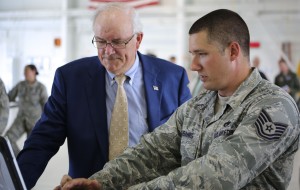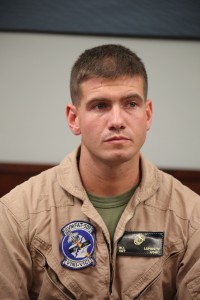2013-09-25 One of the issues Secretary Wynne was briefed on and given a hands on look was Maintenance of Low Observable characteristics approach being shaped at the 33rd FW.
USAF maintainers showed the Secretary how they were addressing the effort and rolling out the LO maintenance capability.
The LO maintainers emphasized that the heritage experience of the USAF from legacy platforms was being leveraged and improvements were then being proliferated to the services new to LO maintenance, the USMC and the USN.

They also emphasized the considerably greater robustness of the LO system on the F-35 compared to the F-22, and prior systems.
They demonstrated various procedures to determine via inspection any operational impacts from the flights on the LO system and the much more automated capabilities they had for this aircraft to shape repair efforts.
For example: the maintainers showed the ability to digitally map the defects and to shape an effective repair procedure.
Indeed, the overall presentations focused on the industrial machine approach as opposed to a craftsmen approach to executing the LO repair process.
Secretary Wynne asked them about the USAF work with the USN in shaping an LO repair approach at see. He asked: “What will the Navy or Marine Corps need to take to sea to repair from an LO perspective their F-35s?”
One of the maintainers responded that they needed to take the tools with them, potentially tailored to their procedures. As well the USN and USMC will have to shape the inspection procedures for determining the presence of defects, which the USAF maintenance officer noted had changed significantly over time with the previous platforms as the USAF gained better understanding of the aircraft and its performance. They expected continuous feedback among the services over time.
The maintainers emphasized that they were staying in close contact with the manufacturers IPT, Lockheed and Northrop Grumman, on shaping the training for this delicate LO maintenance.
“We definitely give feedback to our Lockheed engineers and Northrop engineers. Actually, our Northrop engineer sits in the shop with us. So we have direct communication with them if we have any issues.”

Wynne added “the work you are doing in the F-35 LO effort can be leveraged forward into a new Long Range ISR/Strike platform and can reduce the cost significantly on that new capability by incorporating the new more industrial approaches towards LO that you have invented on the F-35.”And in a related conversation with a USMC airframe maintainer, Sgt, Luhrsen, the challenge of doing LO in a service, which has never, so was highlighted. “It’s a whole new learning curve. We’ve got to actually work with the Air Force now and try to learn their ways because we’ve never had a stealth jet before.”
He added : “We went through their advanced composites course down in Pensacola where they taught us some about it. And then most of it’s just hands on learning with them here at work.”
Sgt. Luhrsen was then asked about some of the specific skill sets being learned for LO maintenance.
“It’s all a learning curve on the techniques. But most of it’s the technique of cutting stuff right and putting it down right. But the tools help some, but it’s all learning. The more you do it, the more you get familiar with it, and the easier it is. So our challenge is to learn the new skills and just be setting the standard for everybody that’s going to come after us.”
For earlier pieces on LO maintenance of the F-35 see the following:
https://www.sldinfo.com/whitepapers/the-f-35-creating-a-21st-century-fighter/

